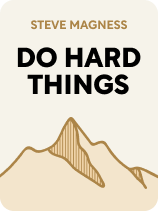

This article is an excerpt from the Shortform book guide to "Do Hard Things" by Steve Magness. Shortform has the world's best summaries and analyses of books you should be reading.
Like this article? Sign up for a free trial here.
Want to become more mentally tough? What are the steps to becoming more resilient?
In Do Hard Things, Steve Magness provides four strategies for becoming a resilient person. These strategies include facing reality, understanding your emotions, listening to your inner voice, and being flexible in life.
Continue reading to learn how to be tough with these four strategies.
Strategy 1: Face Reality
Magness explains his first step in learning how to be tough: facing reality. Facing the reality of a situation and the reality of your capabilities is an important first step because to make the best decisions when facing adversity, you need to accurately assess the problem and what you can do to solve it. There are three ways to face reality:
- Set realistic expectations
- Build inner confidence
- Maintain your autonomy
Strategy 2: Understand Your Emotions
Another key attribute of a truly tough person is the ability to understand your emotions. Magness claims that emotions protect us; they help us navigate the world. If you suppress your feelings and emotions, you’re suppressing your ability to navigate the world effectively. Old-school toughness tells you that you should listen to some emotions (like joy, pride, or anger) while ignoring others (like sadness or fear). Magness, however, claims that you should try to understand and interpret all of your feelings and emotions so that you can make better choices.
Feelings give us important information that we should listen to, claims Magness. Instead of viewing emotions as things that get in our way, as the old-school version of toughness might advise, we should listen and try to understand what our feelings and emotions are telling us. When you understand why you’re feeling a certain way, you can use that information to make better decisions.
Strategy 3: Listen to Your Inner Voices
Another key aspect of toughness, according to Magness, is learning how to interpret and deal with internal debates. When making a decision, we all have several “voices” in our heads pointing us to a certain behavior. In normal, everyday decisions, like deciding what to wear to work, these voices are calm and collected, helping us make a somewhat easy, unimportant choice. In challenging situations, however, ones that require toughness, there might be several voices competing loudly against each other, pushing you toward different behaviors. Navigating these loud voices and making a decision based on them is much more difficult.
Old-school toughness teaches you to simply ignore the voices that don’t align with your goals, like the voice telling you to give up. Magness writes that instead of ignoring these voices, we should acknowledge and respond to them, as when we consciously recognize our doubts, fears, or other emotions, we can make better decisions.
According to one school of thought, we developed inner voices as a way to deal with stress. They serve as a way of making our abstract feelings more tangible. When we address our feelings with our inner voices, we can think about them more concretely, which can help us turn feelings into the appropriate actions or inactions. In other words, while our feelings help us navigate the world, our inner voices and thoughts help us navigate our feelings. The key to toughness is learning how to use our inner voices to our benefit and not letting the negative voices win out and lead us to poor decisions.
According to Magness, there are three strategies we can use to make better use of our inner voices:
Vocalize your thoughts: Putting your thoughts into words can help you focus on the thought you want to be focused on. By vocalizing a thought, you give it more power. Also, since our inner dialogue is often convoluted, vocalizing your thoughts can simplify them and make them more actionable.
Don’t be overly positive: People often try to hype themselves up with positive internal dialogue. According to research, however, this only works if you actually believe what you’re saying to yourself. If you think to yourself, “I can do this,” you aren’t going to trick yourself into believing it. Even when talking to yourself, you have to be realistic.
Think in the second or third person: Magness notes that when we engage in internal dialogue, we often think in the first person—“I’ve got this” or “I’m capable.” But research shows that simply thinking “You got this” or “(your name) is capable” can improve your ability to perform. This is because thinking in the second or third person puts space between yourself and the situation, helping you consider it more objectively and make better decisions.
Strategy 4: Zoom In or Zoom Out
Magness states that true toughness is about learning to deal with pain or discomfort, whether it be mental, physical, or emotional. This means being flexible—broadening or narrowing your focus depending on the situation. Magness claims that the toughest people—those who can thrive in the face of adversity—know when to shift between a broad and narrow state of mind. On the other hand, the only strategy of old-school toughness is to fight against pain and push through. This approach focuses your attention only on the specific task you’re currently working on.

———End of Preview———
Like what you just read? Read the rest of the world's best book summary and analysis of Steve Magness's "Do Hard Things" at Shortform.
Here's what you'll find in our full Do Hard Things summary:
- Why the "old-school" way we think about toughness is wrong
- Why machismo ideals are harmful and ineffective
- How to become resilient and versatile, and how to overcome adversity






